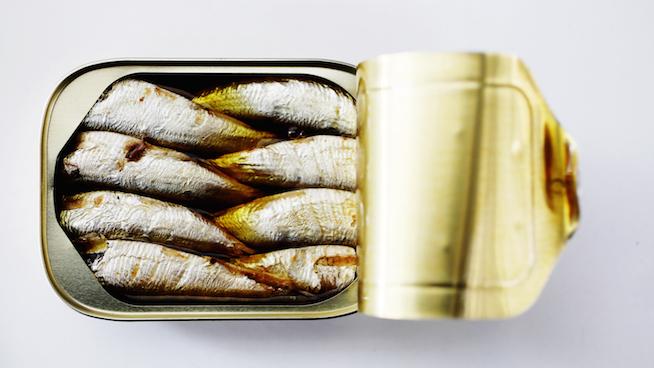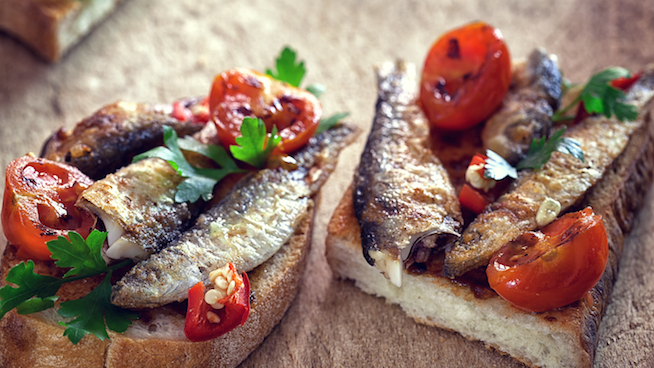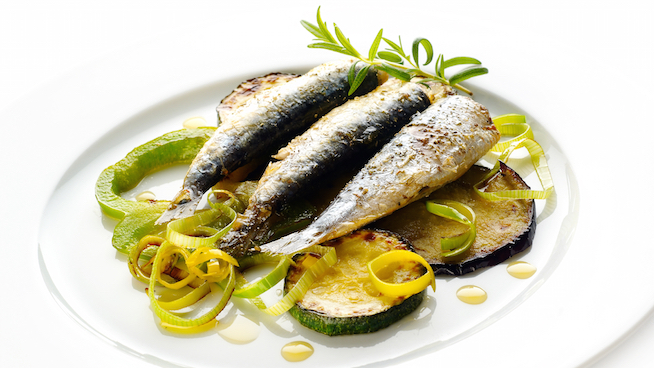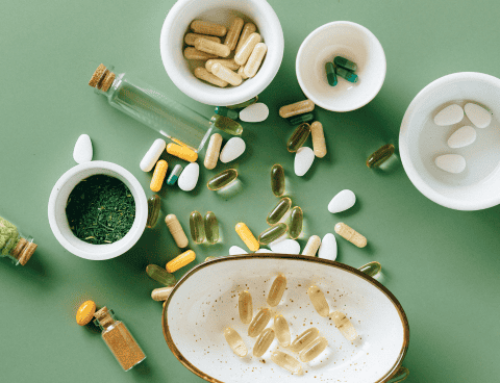Sardines: The Incredibly Powerful Superfood You’ve Probably Been Ignoring
Sardines.
They’re one of the most disrespected foods in America. There seems to be some sort of psychological hold-up that prevents people from even trying the food, let alone making it a part of their daily diet. Perhaps it has something to do with sardines being a hard times staple throughout history, a source of sustenance during economic depressions and times of war. But it’s about time they stopped getting overlooked. Why? Because sardines are one of the most accessible superfoods in existence.
To be clear, I’m talking mainly about canned sardines. They’re more convenient, more affordable and more widely available than fresh sardines, which makes them a much more attractive option for many consumers. I get why people might see canned fish as an inferior option, especially at a time where buzzwords like “farm to table” and “local ingredients” have become synonymous with quality. However, after consulting with experts and the United States Department of Agriculture’s National Nutrient Database, the New York Times concluded fresh fish and canned fish have roughly the same nutritional value. So don’t let the tin fool you—the sardines themselves are still plenty healthy.
RELATED: The NBA’s Vegan Revolution: Why So Many Players Embrace a Plant-Based Diet
While nutrition facts can vary by brand and variety (some sardines are tinned in olive oil, others in spring water, others in sauce, etc.), they all share many of the same strengths. According to the USDA, one can of atlantic sardines canned in oil contains 191 calories, 11 grams of fat, 1.4 grams of saturated fat, 465mg of sodium, 365mg of potassium, 0 grams of carbohydrate and 23 grams of protein. It also contains 35% the recommended daily value (RDV) of calcium, 44% RDV of vitamin D, 136% RDV of vitamin B-12, 15% RDV of Iron, 10% RDV of vitamin B-6 and 9% RDV of magnesium.
Anyway you slice it, that’s a remarkable amount of nutrients in a single package.
Twenty-three grams of protein might be the most appealing aspect of all, especially for athletes. High-quality protein provides the amino acids muscles need to repair and rebuild, allowing you to recover from exercise and get stronger over time. The body can also use protein as a source of energy, and high-protein foods enhance fullness and prevent overeating. Sardines are a complete protein, meaning they contain all nine essential amino acids the human body cannot make on its own. This makes them especially useful, as your body will begin breaking down muscle tissue if your diet doesn’t include substantial amounts of all nine essential amino acids.
Although 11 grams of fat is a significant amount, much of that (about 8.3 grams) is composed of either monounsaturated fats or polyunsaturated fats. Monounsaturated fats help reduce blood pressure and protect against heart disease. They can also help the body better absorb vitamins and more efficiently use protein. Polyunsaturated fats can reduce blood cholesterol levels and lower the risk of heart disease and strokes. The best way to reap the benefits of monounsaturated and polyunsaturated fats is to use them to replace saturated fats in your diet. They’re still fats, so eating too much of them can lead to weight gain and the health risks associated with being overweight. If you’re putting sardines on your sandwich instead of say, bacon (which contains nearly four grams of saturated fat per serving), that’s a really smart nutritional move.
Sardines are a powerhouse of B vitamins. According to the University of Maryland Medical Center, “all B vitamins help the body convert food (carbohydrates) into fuel (glucose), which is used to produce energy. These B vitamins, often referred to as B-complex vitamins, also help the body metabolize fats and protein. B-complex vitamins are needed for healthy skin, hair, eyes, and liver. They also help the nervous system function properly.” All of those things are pretty darn important, yet many Americans are deficient in B vitamins. Vitamin B-12 seems especially elusive in the Standard American Diet, as the CDC estimates nearly 25% of adults over the age of 50 are either deficient or borderline deficient. The fact that a serving of sardines serves up a whopping 136% the RDV certainly helps its case as a superfood.
In fact, sardines seem to be a sort of Swiss army knife for preventing common vitamin deficiencies. Aside from vitamin B-12, Americans are also frequently deficient in vitamin D, Iron, Calcium and Magnesium. A serving of sardines contains 44%, 15%, 35% and 9% the RDV of each of these vitamins, respectively.
Vitamin D is closely associated with bone health, but it also has been found to have a big impact on athletic performance. In 2014, half the New York Giants roster found out they were deficient in vitamin D thanks to a team-wide blood analysis. Iron is a key component of hemoglobin and it’s critical for transporting oxygen-rich blood throughout the body. Like vitamin D, Iron also plays an important role in athletic performance. Just ask Giants cornerback Eli Apple, who was diagnosed with an iron deficiency while he was at Ohio State. He went from being unable to finish workouts to becoming a first-round draft pick once he addressed his deficiency. Calcium is crucial for building and maintaining strong bones and teeth and maintaining prove nerve and muscle function. Every organ in the body needs magnesium to operate properly. Low levels of dietary magnesium have been associated with a huge range of unfavorable health outcomes, including asthma, depression, diabetes and heart failure. Magnesium also plays a crucial role in energy production, making it a critical mineral for athletes who want to perform their best.
One of the few concerns regarding sardines are the sodium content. 465mg of sodium is a considerable amount, no doubt. But if you’re worried about your sodium intake (the recommended daily level is 1,500mg), you can simply opt for sardines in water with no salt added. You’ll still get the same basic nutritional profile, just with much less salt (about 100mg per tin).
RELATED: 5 Foods That Are Stunningly High in Sodium
Another plus is that sardines are very low in contaminants such as mercury. You can’t see, taste or smell the mercury in fish, and cooking has no effect on it. Mercury exposure is an especially important concern for young children, women who are pregnant or those who are expecting to become pregnant. The higher a fish is in the food chain, generally the higher in mercury it will be. Since sardines are so small and so low in the food chain, they’re considered quite safe to eat.
The Harvard T.H. Chan School of Public Health states that research indicates “eating approximately one to two 3-ounce servings of fatty fish a week—salmon, herring, mackerel, anchovies or sardines—reduces the risk of dying from heart disease by 36 percent.” Unfortunately, most Americans fall woefully short of this mark. There are several reasons why beef and chicken consumption still dwarf seafood in the U.S. Perhaps it’s because they’re easier to locate. Perhaps it’s because because they’re more affordable. Perhaps it’s because they’re seen as more versatile. While these justifications are all logical enough, they shouldn’t apply to canned sardines. Sardines are widely available, as you can buy a tin in almost any supermarket. They’re also quite reasonable—you can buy a 12-pack of the best-selling sardines on Amazon for a little over $2 a can. Then there’s the convenience factor. Canned sardines don’t need to be cooked, meaning they can be an effortless addition to a sandwich, salad, pasta, cracker or piece of toast. You don’t have to worry about them going bad, either—according to the FDA, canned sardines can last as long as five years if stored properly.
If you’re one of the millions of Americans who doesn’t include enough fatty fish in your diet, sardines are an extremely convenient way to close the gap. If I’ve sold you on sardines being your next superfood, all that’s left is to give them a try. Expect a salty, oily taste. It might take a while to grow on you, but given the extreme versatility of sardines, you should be able to find a preparation where you enjoy them.
Photo Credit: circlePS/iStock, Celeste Duffy/iStock, tomonikon/iStock
READ MORE:
RECOMMENDED FOR YOU
MOST POPULAR
Sardines: The Incredibly Powerful Superfood You’ve Probably Been Ignoring
Sardines.
They’re one of the most disrespected foods in America. There seems to be some sort of psychological hold-up that prevents people from even trying the food, let alone making it a part of their daily diet. Perhaps it has something to do with sardines being a hard times staple throughout history, a source of sustenance during economic depressions and times of war. But it’s about time they stopped getting overlooked. Why? Because sardines are one of the most accessible superfoods in existence.
To be clear, I’m talking mainly about canned sardines. They’re more convenient, more affordable and more widely available than fresh sardines, which makes them a much more attractive option for many consumers. I get why people might see canned fish as an inferior option, especially at a time where buzzwords like “farm to table” and “local ingredients” have become synonymous with quality. However, after consulting with experts and the United States Department of Agriculture’s National Nutrient Database, the New York Times concluded fresh fish and canned fish have roughly the same nutritional value. So don’t let the tin fool you—the sardines themselves are still plenty healthy.
RELATED: The NBA’s Vegan Revolution: Why So Many Players Embrace a Plant-Based Diet
While nutrition facts can vary by brand and variety (some sardines are tinned in olive oil, others in spring water, others in sauce, etc.), they all share many of the same strengths. According to the USDA, one can of atlantic sardines canned in oil contains 191 calories, 11 grams of fat, 1.4 grams of saturated fat, 465mg of sodium, 365mg of potassium, 0 grams of carbohydrate and 23 grams of protein. It also contains 35% the recommended daily value (RDV) of calcium, 44% RDV of vitamin D, 136% RDV of vitamin B-12, 15% RDV of Iron, 10% RDV of vitamin B-6 and 9% RDV of magnesium.
Anyway you slice it, that’s a remarkable amount of nutrients in a single package.
Twenty-three grams of protein might be the most appealing aspect of all, especially for athletes. High-quality protein provides the amino acids muscles need to repair and rebuild, allowing you to recover from exercise and get stronger over time. The body can also use protein as a source of energy, and high-protein foods enhance fullness and prevent overeating. Sardines are a complete protein, meaning they contain all nine essential amino acids the human body cannot make on its own. This makes them especially useful, as your body will begin breaking down muscle tissue if your diet doesn’t include substantial amounts of all nine essential amino acids.
Although 11 grams of fat is a significant amount, much of that (about 8.3 grams) is composed of either monounsaturated fats or polyunsaturated fats. Monounsaturated fats help reduce blood pressure and protect against heart disease. They can also help the body better absorb vitamins and more efficiently use protein. Polyunsaturated fats can reduce blood cholesterol levels and lower the risk of heart disease and strokes. The best way to reap the benefits of monounsaturated and polyunsaturated fats is to use them to replace saturated fats in your diet. They’re still fats, so eating too much of them can lead to weight gain and the health risks associated with being overweight. If you’re putting sardines on your sandwich instead of say, bacon (which contains nearly four grams of saturated fat per serving), that’s a really smart nutritional move.
Sardines are a powerhouse of B vitamins. According to the University of Maryland Medical Center, “all B vitamins help the body convert food (carbohydrates) into fuel (glucose), which is used to produce energy. These B vitamins, often referred to as B-complex vitamins, also help the body metabolize fats and protein. B-complex vitamins are needed for healthy skin, hair, eyes, and liver. They also help the nervous system function properly.” All of those things are pretty darn important, yet many Americans are deficient in B vitamins. Vitamin B-12 seems especially elusive in the Standard American Diet, as the CDC estimates nearly 25% of adults over the age of 50 are either deficient or borderline deficient. The fact that a serving of sardines serves up a whopping 136% the RDV certainly helps its case as a superfood.
In fact, sardines seem to be a sort of Swiss army knife for preventing common vitamin deficiencies. Aside from vitamin B-12, Americans are also frequently deficient in vitamin D, Iron, Calcium and Magnesium. A serving of sardines contains 44%, 15%, 35% and 9% the RDV of each of these vitamins, respectively.
Vitamin D is closely associated with bone health, but it also has been found to have a big impact on athletic performance. In 2014, half the New York Giants roster found out they were deficient in vitamin D thanks to a team-wide blood analysis. Iron is a key component of hemoglobin and it’s critical for transporting oxygen-rich blood throughout the body. Like vitamin D, Iron also plays an important role in athletic performance. Just ask Giants cornerback Eli Apple, who was diagnosed with an iron deficiency while he was at Ohio State. He went from being unable to finish workouts to becoming a first-round draft pick once he addressed his deficiency. Calcium is crucial for building and maintaining strong bones and teeth and maintaining prove nerve and muscle function. Every organ in the body needs magnesium to operate properly. Low levels of dietary magnesium have been associated with a huge range of unfavorable health outcomes, including asthma, depression, diabetes and heart failure. Magnesium also plays a crucial role in energy production, making it a critical mineral for athletes who want to perform their best.
One of the few concerns regarding sardines are the sodium content. 465mg of sodium is a considerable amount, no doubt. But if you’re worried about your sodium intake (the recommended daily level is 1,500mg), you can simply opt for sardines in water with no salt added. You’ll still get the same basic nutritional profile, just with much less salt (about 100mg per tin).
RELATED: 5 Foods That Are Stunningly High in Sodium
Another plus is that sardines are very low in contaminants such as mercury. You can’t see, taste or smell the mercury in fish, and cooking has no effect on it. Mercury exposure is an especially important concern for young children, women who are pregnant or those who are expecting to become pregnant. The higher a fish is in the food chain, generally the higher in mercury it will be. Since sardines are so small and so low in the food chain, they’re considered quite safe to eat.
The Harvard T.H. Chan School of Public Health states that research indicates “eating approximately one to two 3-ounce servings of fatty fish a week—salmon, herring, mackerel, anchovies or sardines—reduces the risk of dying from heart disease by 36 percent.” Unfortunately, most Americans fall woefully short of this mark. There are several reasons why beef and chicken consumption still dwarf seafood in the U.S. Perhaps it’s because they’re easier to locate. Perhaps it’s because because they’re more affordable. Perhaps it’s because they’re seen as more versatile. While these justifications are all logical enough, they shouldn’t apply to canned sardines. Sardines are widely available, as you can buy a tin in almost any supermarket. They’re also quite reasonable—you can buy a 12-pack of the best-selling sardines on Amazon for a little over $2 a can. Then there’s the convenience factor. Canned sardines don’t need to be cooked, meaning they can be an effortless addition to a sandwich, salad, pasta, cracker or piece of toast. You don’t have to worry about them going bad, either—according to the FDA, canned sardines can last as long as five years if stored properly.
If you’re one of the millions of Americans who doesn’t include enough fatty fish in your diet, sardines are an extremely convenient way to close the gap. If I’ve sold you on sardines being your next superfood, all that’s left is to give them a try. Expect a salty, oily taste. It might take a while to grow on you, but given the extreme versatility of sardines, you should be able to find a preparation where you enjoy them.
Photo Credit: circlePS/iStock, Celeste Duffy/iStock, tomonikon/iStock
READ MORE:














